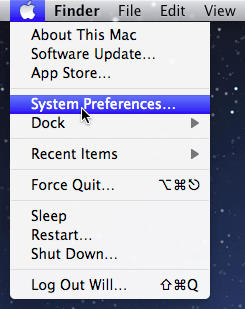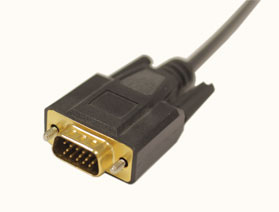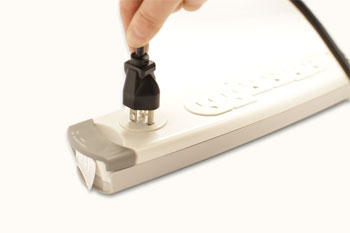Getting to know your computer's OS
The screen you see when your computer has finished starting up is called the desktop. Depending on what kind of operating system you have, the desktop will look different, but it generally consists of menus at the bottom, top, and/or sides of the screen, with the rest of the screen containing a desktop background, or wallpaper. The desktop background area can also contain any files, applications, or shortcuts you want to have quick access to.
Getting to know the desktop
Both PCs and Macs have desktops, but their desktops look a bit different. The interactives below will introduce you to the Windows and Mac desktops.
Click the buttons in the interactive below to learn more about the Windows desktop.

Taskbar
The taskbar contains shortcuts to applications, the date & time, and more. When you open a program or file, it will appear on the taskbar, and you can easily switch between different programs by selecting them on the taskbar.

Click the buttons in the interactive below to learn more about the OS X desktop.

If you have difficulty seeing or hearing—or if you have trouble manipulating the mouse or keyboard—there are settings that can help make your computer easier to use. To learn more, check out our lesson on Accessibility Features.
Your computer's file system

No matter which operating system you use, your computer uses folders to organize all of the different files and applications it contains. Folder icons on your computer are designed to look like file folders full of documents or pictures.
Each operating system has its own file system, which helps you find your folders and files. If your PC runs on Windows 7 or earlier, your file system will be called Windows Explorer (not to be confused with Internet Explorer, which is the PC's pre-installed web browser). If your PC runs on Windows 8, the file system will be called File Explorer. The file system for Macs is called Finder. Here, we'll talk about the basic functions that are common to all computer file systems.
To find out more about file systems on Macs, check out the lesson on Working with Files in our OS X Basics tutorial. To learn more about PC file systems, take a look at the Working with Files lesson in our Windows Basics tutorial.
Opening your computer's file system
Whether you're using a PC or a Mac, the file system icon will be in the bottom-left part of the screen. On a PC, the Windows Explorer icon looks like a folder, as in the image below.

On a Mac, the Finder icon looks like a face and will be located in your Dock, as seen below.

In both operating systems, you can also open the file system by clicking a folder from your desktop.
Basic navigation
Whether you're using Windows Explorer or Finder, basic navigation is the same. If you see the file you want, you can double-click it. Otherwise, you can use the Navigation pane on the left side of the window to select a different location.

Deleting files
Windows and OS X use a Trash can—or Recycle Bin—to prevent you from accidentally deleting files. When you delete a file, it is moved to the Trash can. If you change your mind, you can move the file back to its original location. If you're sure you want to permanently delete the file, you will need to empty the trash or recycle bin.
Opening applications
When you double-click a file, it will automatically open in the default application for that file type. However, sometimes you may want to open an application directly.
To open an application on a PC:
- Click the Start button, then select the desired application. If you don't see it, you can click All Programs to see a complete list. In our example, we've opened Internet Explorer. For convenience, commonly used applications may also have a shortcut on the taskbar or on the desktop.

In Windows 8, there is no Start menu, so you'll usually open applications from the Start screen. To learn more, check out our lesson on Getting Started with Windows 8.
To open an application on a Mac:
- Click the application's icon on the Dock. If you don't see it, click the Spotlight icon in the top-right corner of the screen and type the name of the application.

If you are using OS X Lion or a more recent version of OS X, you can also click the Launchpad icon on the Dock to select an application.
Adjusting your computer's settings
When you start using a new computer, you may want to begin by adjusting the computer's settings. Adjusting your settings can range from simple tasks such as changing your desktop background to more advanced tasks like adjusting your security or keyboard settings. On PCs, the Control Panel is used to adjust settings. On Macs, you'll use System Preferences.
To access your computer's settings:
- In Windows 7 or earlier, click the Start button, then select Control Panel.

- In Windows 8, you can open the Control Panel directly from the Start screen. Using your keyboard, typeControl Panel and press the Enter key.

- On a Mac, click the Apple icon, then select System Preferences.

For more information on changing settings on a PC, check out the Adjusting Your Settings lesson in our Windows Basics tutorial.
For more information on changing settings on a Mac, take a look at the Adjusting Your Settings lesson in our OS X Basics tutorial.
Shutting down your computer
When you're done using your computer, it's important to shut it down properly. Depending on your operating system, the exact procedure for shutting down will vary.
To shut down in Windows 8:
Click the Start button to access the Start screen, click the Power button  near the top-right corner, and select Shut down.
near the top-right corner, and select Shut down.
To shut down in Windows 7 or earlier:
Click the Start button, then select Shut down (in some versions, this may say Turn Off Computer or look like the power symbol  ).
).

To shut down in Mac OS X:
Click the Apple icon, then select Shut Down.












